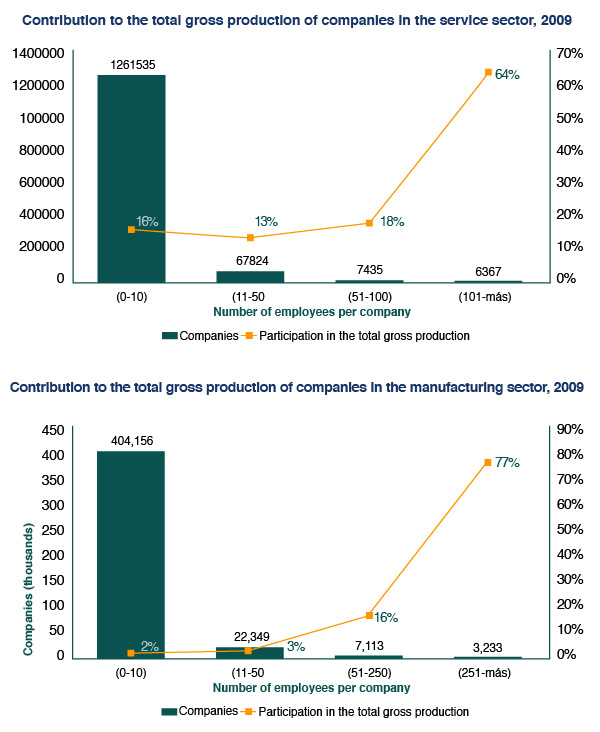The Challenges of Innovation in Mexico
Posted By Ceci On 9 December, 2013 @ 2:26 pm In Entrepreneurship,Edición 47 | No Comments
 By: Claudia González
By: Claudia González
Like many countries of the world, Mexico sees the impetus toward science, technology and innovation (STI) as a key strategy for its economic and social development.
Like many countries of the world, Mexico sees the impetus toward science, technology and innovation (STI) as a key strategy for its economic and social development. The country gives prime importance to STI, and the Constitution stipulates the support that the government should provide to these activities.
In addition, there is a Law of Science and Technology (C&T), which lays down the foundation of the National System of Science, Technology and Innovation. This was conceived as the guiding principle of the economy and is expected to help raise the country’s competitiveness so it can achieve substantial growth and a better distribution of wealth.
However, expenditures on research and experimental development have remained at around 0.4% of the GDP for more than two decades, and the impression is that the participation of STI in the country’s economy has been moderate. Looking at the history of STI in our country allows us to better understand our current context.
The STI system in Mexico began in the 1930s with the creation of the National Institutes of Health. Government support was dedicated almost exclusively to improving the nation’s health. It was not until 1960, with the creation of the Institute for Scientific Research, that the country took a first step toward consolidating its STI system.
The Institute’s main function was to provide scholarships to fund undergraduate college theses and the pursuit of graduate studies. But the real evolution of the system did not occur until the 1970′s when there was an unprecedented expansion of the higher education system. The majority of the state universities and the third largest public university in Mexico City were established in that decade. At that time, the country’s economic policy was based on import substitution, and raising the educational level of the labor force was seen as critical.
The National Council for Science and Technology (Conacyt) was also created in 1970. It took on the functions of the Institute of Scientific Research and started awarding grants for research projects. Even though Conacyt administered relatively limited resources, its creation meant that the government would have the STI on its agenda, and as a result, a small but active scientific community was established.
The decade of the 80s was marked by economic stagnation, and the development of STI was not excluded from this situation. By the end of this decade, both trade and STI started changing significantly. In terms of international trade, the country became a member of the General Agreement on Tariffs and Trade (GATT) and in 1992 it signed the North American Free Trade Agreement (NAFTA). In that same year, the World Bank gave Mexico its first loan for science and technology, called the Science Support Program in Mexico (Pacime).
This program provided a little more than 300 million dollars in matching funds by the government and the World Bank to support primarily scientific activities. These funds were used for research projects, scientific infrastructure, repatriation and retention of scientists, and endowed chairs. These programs had a significant impact on STI investment. Research and experimental development expenditure, as a percentage of the GDP, rose from 0.28% in 1990 to 0.33% in 1991. By 1994, it had reached 0.41%, roughly what it is today.
During the 1990s, the main objectives of the S&T policy were to increase the country’s capacity in scientific research, and to train high-level human resources. Supporting technological development and innovation was not a priority at that time.
For example, in Conacyt’s 1993 budget, 26% went to strengthening scientific capabilities, 29% scholarships (both nationally and abroad), 20% to the National System of Researchers (SNI), and only 2% to technology, with the remaining 23% for other programs. This budgetary distribution remained during the rest of the decade. Without a doubt, these programs had a favorable impact on the country’s capabilities of scientific research. According to the Institute for Scientific Information (ISI), the participation of Mexican scientists in the global scientific production increased from 0.2% in 1993 to 0.5% a decade later.
With the arrival of the new century, the STI system had grown in size, output and international impact, but its investment as a percentage of the national GDP remained at the same low level. In spite of the few resources spent on technology and innovation during the decade of the 90s, Conacyt designed various programs to promote technological development.
However, the scarcity of resources, together with the high interest rates that prevailed at that time, the lack of capacity for technological risk evaluation, and poor program design, led to very low demand for these programs. Their impact was modest, at best.
Toward the end of the 1990s, new programs were created to promote innovation. In 1998, the World Bank awarded a second loan, called the Program of Knowledge and Innovation (PCI in Spanish). Specific resources to support innovation were earmarked in this program. Also, a system of fiscal incentives for S&T was established.
But very few companies benefitted from these new initiatives. In 1999, only 20% of the national expenditure on research and experimental development was invested by the private sector.
As the millennium began, an attempt was made to give new impetus to innovation. One of the first instruments was a new S&T law which, among other things, requires that 1% of GDP be committed to research and experimental develop expenditure. The law also placed special emphasis on linking scientific activities to national problems. This effort included the creation of new programs, among them the Mixed Funds and the Sectorial Funds. The Mixed Funds, which operated with matching funds between Conacyt and state governments, were directed to regional development. The Sectorial Funds, which operated with matching funds between Conacyt and federal agencies, were to address the most relevant national problems.
To foster innovation, the AVANCE program was created in 2003. It included three modalities: Last Mile, which supported the pre-commercial stage of innovation; Entrepreneurs Fund, which supplied angel capital to companies; and the Warranty Fund, which helped securing bank loans. The new Law generated strong expectations, but these expectations were not completely met. Investment levels in S&T remained without significant changes, and the new programs had a relatively low demand, relative to the size of the country’s economy.
The most important change that occurred in recent years has been the significant increase in the participation of the private sector in the R&D expenditure. Currently, about 40% is provided by this sector, and government participation is little more than 50%. However, as Dutrenit (et al 2010) mentions, the private sector’s reorientation of the R&D expenditures should be interpreted with caution. Despite the increase in spending, there has not been an increase in the level of patents (patenting activity) by domestic companies – nor has there been an increase in the level of competitiveness of the country, or in the technological trade balance.
Mexico’s innovation process lacks coordination among the actors of the national innovation system, and the private sector is one of the weakest links. Companies invest very little in innovation, which means having an infrastructure with very little technological development and a shortage of highly trained human resources. Similarly, the link between companies, and higher education and research centers is very limited.
The country’s industrial ecosystem is primarily made up of micro, small and medium-sized enterprises. There are more than 4.5 million micro businesses (with fewer than 10 employees). About 90% of the companies employ less than 50 people, and they devote themselves to services and small-scale agriculture, with its production oriented to local markets. In addition, there are very few innovators, and their contribution to the total value of production is low.

In addition, production is highly concentrated in a few States – 10 of them generate 41% of the GDP.
The challenges of the Mexican system of innovation are complex and of a highly diverse nature. One of the most important is access to private sources of funding. Suppliers generally finance companies in Mexico. The use of bank credit is an expensive resource, and limited only to a small group of companies. The capital market, both public and private, is small. Entrepreneur capital in Mexico lags greatly behind, compared with other countries, barely reaching 0.004% of the GDP. It is also difficult for research and development expenditure to reach 1% of the GDP unless private investment is increased substantially.
Another great challenge is to efficiently coordinate the different actors, in order to create a true innovation ecosystem. But to do this, it is necessary to develop the internal capacity to generate knowledge and technology, so that the business sector takes full advantage of such knowledge. There is no doubt that the business sector must play a fundamental role in innovation, and for this to happen, the most important thing is changing the culture toward innovation in this sector.
Another important challenge is to attract researchers’ interest in participating in innovation projects. They could either do this jointly with the private sector, or become entrepreneurs themselves. University incubators, for the most part, have not succeeded in enlisting a critical mass of high-technology projects, to justify the participation and use of the university infrastructure. A prerequisite is to increase the entrepreneurial culture in technology-based companies, and this is where the ITAM Center of Creativity, Innovation and Entrepreneurship can play a critical role in the future development of our country.?
References
- Dutrénit, G., Capdeville, M., Corona, J., Puchet, M., Santiago, F. & Vera-Cruz, A., (2010), El Sistema Nacional de Innovación Mexicano: Instituciones, Políticas, Desempeño y Desafíos, México, UAM-X
- OECD (2009). Reviews of Innovation Policy, Mexico, OECD, Paris.
- INEGI (2009). Censo Económico, Mexico.
Article printed from Dirección Estratégica: http://direccionestrategica.itam.mx
URL to article: http://direccionestrategica.itam.mx/los-retos-para-la-innovacion-en-mexico/